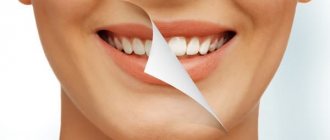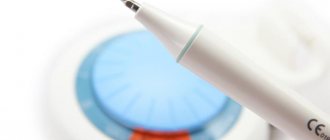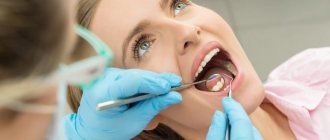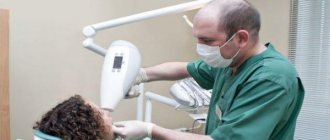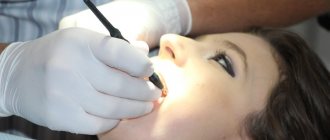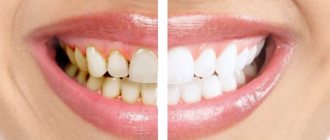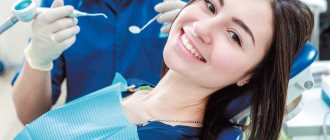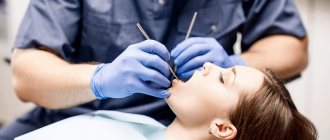Professional oral hygiene is comprehensive care aimed at preventing dental diseases. The technology allows you to get a “brilliant” result in one hour and achieve natural whiteness.
The procedure includes removing plaque using the Air Flow method and cleaning hard plaque with an ultrasonic scaler. At the final stage, fluoridation and remotherapy are performed to strengthen the enamel. In addition, the attending physician teaches the patient about home hygiene and selects care products. Professional care is highly effective, but maintaining the results is only possible if all the dentist’s instructions are followed.
Enamel sensitivity
May increase in the first days after professional hygiene. At first, to avoid pain, it is better not to consume sour or very sweet foods and drinks. It is not recommended to consume cold and hot at the same time or too cold, hot drinks and foods. This is dangerous not only by increasing the sensitivity of the enamel, but also by weakening it and the appearance of microcracks on its surface.
To prevent enamel sensitivity from increasing after professional cleaning, it is better to complete the procedure with remineralization or fluoridation. This will strengthen the enamel and remove discomfort.
If the enamel is weakened, after cleaning, the doctor may additionally prescribe special products, toothpastes, to strengthen it.
If severe pain persists after the procedure or the pain does not decrease within several days, you should consult a dentist.
Review and detailed analysis of all stages of comprehensive teeth cleaning
Professional teeth cleaning is a process of several stages, using certain technologies. Initially, the hygienist removes deposits that have hardened and formed a special stone on the teeth. Such deposits can be eliminated through the use of ultrasonic equipment.
Ultrasonic teeth cleaning
Tartar is hardened (or mineralized, in more professional terms) deposits on certain areas of the tooth.
Based on the area of formation, tartar is divided into supragingival and subgingival. The second type poses the greatest danger to humans, since it very often leads to gum inflammation in the future. Simple methods cannot get rid of such deposits, and only the use of ultrasonic equipment can eliminate them.
When performing cleaning, ultrasonic waves destroy deposits even in the most difficult to reach areas, and at the same time harmful microflora, which can lead to inflammation. Timely use of teeth cleaning will help avoid various dental problems. Such as, for example, periodontitis or periodontal disease.
Dentists use a special device (scaler) to solve these problems. It creates the necessary ultrasonic waves. It has a tip with a special attachment that transmits waves to the areas that need to be treated. It is also supplied with water or antiseptic. The dentist, using the device, can change the intensity of vibrations, selecting the most suitable mode for the patient.
How is tartar removed?
When performing such cleaning, it is destroyed due to the following:
- Ultrasound has a mechanical effect on hardened areas. The waves gently crush the stone into small pieces, which are easily removed with water or a special vacuum cleaner for the oral cavity;
- The simultaneous supply of liquid and ultrasound leads to the formation of a cavitation effect, during which a huge number of microbubbles are created. They blur plaque and speed up its separation from the tooth surface.
Important! Before it became possible to use ultrasound, tartar was removed exclusively with hand tools. Because of this, the procedure was very long and complicated. The dentist could easily injure the soft tissues, since the instrument used was extremely sharp, so the whole procedure could hardly be called pleasant. The most negative point in all this was that during the procedure, tooth enamel was significantly damaged. This was due to the fact that to remove plaque it was necessary to remove a layer of healthy tissue. After performing this type of cleaning, patients often experienced unpleasant dental hypersensitivity. The use of ultrasound allows you to avoid all these problems. Ultrasonic cleaning is absolutely safe; it does not injure the gums or mucous membranes.
It is very important that all procedures are carried out using modern equipment, without any disruptions in the process, only then the cleaning will be carried out professionally and will be safe. To do this, it is important that the hygienist has experience working with a scaler: the tip of the device should move only along areas of the tooth at a specific angle, and the cleaning itself should be accompanied by a significant supply of water to the teeth. It is very important to follow this process technology, since violations can damage the enamel or overheat the pulp, which can lead to various complications.
Our dental clinic carries out such cleaning only under the guidance of professional hygienists, as well as using modern equipment, so patients have nothing to fear and are guaranteed an impeccable result.
Important! A positive feature of using ultrasound, as opposed to other types of cleaning (with the exception of laser cleaning), is that it kills pathogenic microflora. For this reason, this procedure is highly recommended for patients with gum disease, because ultrasound kills pathogenic microflora in all areas, including periodontal pockets.
You should not be afraid of such cleaning, because it does not cause pain at all. If you are concerned that they may occur, you can ask the hygienist to pre-administer anesthesia. With this option there will definitely be no pain. Otherwise, ultrasonic cleaning is very fast. Up to 60 minutes, the exact time depends on how much deposits are observed in the oral area.
Important! If you have hypersensitivity or have a lot of deposits in the subgingival pockets, then there may be some pain during ultrasonic cleaning, and this is normal. In order to remove them, you need to administer anesthesia before cleaning. It can be administered not by injection, but by applying a local application. Therefore, there is no need to be afraid or panic.
Once this stage has been successfully completed, the hygienist moves on to the next stage and performs cleaning using Air Flow technology.
2.Air Flow
During the Air Flow teeth cleaning procedure, a special sandblasting device is used, which, using air and water, delivers a composition with abrasive particles to the enamel surface. The liquid is supplied in a powerful stream, which allows you to cleanse your teeth of bacteria and plaque in a short period of time. This method is effective not only for removing loose deposits, but also pigmented plaque that is firmly embedded in the enamel.
Air Flow is an innovative technology for cleaning teeth, which has a number of undeniable advantages:
- Air Flow easily fights plaque located in hard-to-reach areas of the oral cavity, which helps get rid of bad breath.
- The procedure can be performed without the use of anesthesia. It does not cause pain or discomfort. Mild pain may occur in patients with hypersensitivity.
- During the Air Flow procedure, aromatic liquids are used that can give freshness to your breath and turn cleaning into a pleasant, painless process.
- In liquids for the Air Flow procedure, soda is used, crushed to a powder state. This means that the risk of injury to tooth enamel during the cleaning process is completely eliminated.
- Air Flow effectively removes pigmented plaque. The procedure is indispensable for smokers and lovers of strong coffee and black tea. Excessive consumption of coffee and tobacco negatively affects the whiteness of the enamel, making it yellow. Air Flow quickly removes unpleasant plaque, restoring your teeth to their attractive appearance.
- During cleaning, do not use liquids with caustic chemical composition. This means that cleaning is safe and does not cause allergic reactions or other unpleasant consequences.
- The air-abrasive flow helps restore teeth to their natural white color and make your smile more attractive.
IMPORTANT: Using Air Flow technology, the doctor independently adjusts the power of the water-air flow onto the enamel surface, taking into account the individual characteristics of the patient’s teeth. The dentist takes into account the structure and condition of the enamel and whether there is hypersensitivity. This approach helps to achieve high efficiency and complete safety for patients.
Why does professional cleaning combine two techniques - Air Flow and ultrasound?
This question worries many patients. Hygienists explain that only a combination of two cleanings can achieve the desired result and carry out the procedure for cleansing the oral cavity from bacterial plaque at the proper level.
Air Flow cleaning works great at removing pigmented plaque that has become embedded in the pores of the enamel, but it will not be able to remove hard tartar, and is ineffective in the presence of mineralized deposits located in periodontal pockets.
Ultrasonic cleaning works well to remove tartar, but the metal tip of the scaler cannot penetrate the space between teeth (it is especially difficult to clean the interdental space in patients whose teeth are too close together). That is why these methods are used in combination. During professional cleaning, ultrasound and Air Flow methods are used.
IMPORTANT: Air Flow and ultrasonic cleaning can lighten tooth enamel to a natural level - by 2 tones. For those who want to achieve a more pronounced effect, after cleaning they should resort to a professional whitening procedure.
Teeth polishing is one of the mandatory stages of professional cleaning.
The third stage of brushing your teeth involves mandatory polishing of your teeth. Using polishing, the dentist eliminates all irregularities and microcracks in the enamel that form after cleaning the teeth of accumulated deposits. Professional teeth cleaning is impossible without polishing, since roughness will remain on the enamel, which promotes the adhesion of microparticles of food.
As a result, a layer of plaque forms again, which subsequently mineralizes and turns into tartar. Teeth polishing carried out after professional cleaning significantly slows down the process of plaque formation and keeps teeth shiny and smooth for a long time.
Teeth polishing after brushing is carried out using a special tool with several replaceable attachments. Each of them performs a specific task:
- Needle-shaped attachments are used to grind the surfaces of teeth and the gingival zone;
- Brushes help remove remaining plaque particles from rough areas of teeth;
- Crowns and dentures made of different materials are processed with different types of polishers;
- Discs allow you to give ideal smoothness and shine to cleaned teeth.
Treatment of interdental spaces after professional cleaning is carried out using special strips, as they easily fit into the narrow space between the teeth.
The process of polishing teeth after professional cleaning involves the use of not only tools, but also several types of pastes with varying degrees of abrasiveness. In addition to abrasive particles, polishing pastes contain fluorine and xylitol, which are involved in strengthening teeth.
Stages of teeth polishing after professional cleaning
- Polishing the outer surface of teeth using tools and paste;
- The treatment of flat surfaces is followed by polishing the fissures (tubercles) of the chewing teeth;
- Polishing the spaces between teeth with strips.
The average duration of teeth polishing performed after professional cleaning is 30-40 minutes. This does not require anesthesia, since the process of polishing teeth is a painless procedure that does not cause discomfort to the patient. Upon completion of polishing, the oral cavity must be rinsed with water, after which the dentist carries out the final stage of professional teeth cleaning - fluoridation.
4. Fluoridation is the final stage of professional teeth cleaning
Fluoridation is not a mandatory procedure after professional teeth cleaning, but you should not refuse it, as it combats increased sensitivity of teeth, strengthens enamel and prevents the occurrence of caries. Fluoridation involves treating tooth surfaces with fluorides.
Benefits of fluoridation:
- Normalizing the level of fluoride in the body, strengthening teeth and increasing the strength of enamel;
- Stops the process of leaching calcium, which is so important for dental health;
- Slowing down the proliferation of pathogenic bacteria in the oral cavity and the formation of plaque.
The process of fluoridation of teeth occurs as follows: the teeth are dried with an air stream directed at them. Next, using trays or a brush, a solution enriched with useful substances is applied to each tooth. Fluoridation is the final stage of professional teeth cleaning. But after the procedure, every dentist will definitely give recommendations on proper care of your teeth and oral cavity.
Additional care products
Dental floss, floss. Used to clean interdental spaces. After professional cleaning, use floss carefully so as not to injure the edges of the gums. Movements are directed from the gums to the cutting edge or to the chewing surface of the crown. Floss is used several times a day, as needed (after meals, after morning and evening brushing of teeth).
Irrigator. Using an irrigator helps to maintain the results of professional hygiene for a long time. The device cleans enamel with a thin stream of water under pressure. This type of cleaning removes soft plaque well and prevents the formation of tartar. The irrigator is used once a week or less. It is better if the frequency of such cleanings is determined by a doctor, taking into account the condition of the enamel.
After cleaning dentures
In cases where the patient already has orthopedic structures installed, professional teeth cleaning is recommended at intervals of 3-4 months.
This depends on how carefully, correctly and regularly individual hygiene is carried out in the presence of artificial crowns, bridges and other types of prostheses, which determines the degree of healthy condition of one’s own teeth in contact with existing orthopedic structures.
Particular attention should be paid to the areas of contact between the prosthesis and the gingival margin. The appearance of a defect in the contact area makes it difficult to clean it and contributes to the intensive accumulation of plaque and food debris under the denture.
Prohibited Products
In the first 2-3 days after cleaning, you should not eat foods that can stain your teeth enamel an unnatural color. In particular, the following products should be completely excluded:
- red: tomatoes, berries, beets and various sauces;
- yellow: curry and mustard;
- brown and black: chocolate, soy sauce, blueberries, blackberries.
It is also recommended to exclude the consumption of sweets and ice cream. This is explained by the fact that after the procedure, the teeth and gums become extremely sensitive. Cold foods will cause significant damage to the enamel.
Products with unnatural dyes, such as yoghurt and soda, should be excluded. Completely give up cocoa and coffee, as well as chocolate. Consuming these products immediately after hygienic cleaning can cause your teeth to turn dark.
Drinks that can stain tooth enamel, such as red wine and tomato juice, are also prohibited. Coffee is the main enemy of this thin coating after cleansing. If you can’t give up the habit of starting the day with coffee, it’s better to drink it with milk and through a straw. And after drinking a cup, you should rinse your mouth with clean water.
10 Habits That Are Harmful to Your Smile
In general, experts disagree on when you can start drinking coffee or eating “colored” foods. Some argue that you need to wait the required three days, while others say that you should limit your diet for at least a week.
In order not to risk newly cleaned teeth and a snow-white smile, it is better to follow the “diet” for a week or more. It is better to give up bad habits such as smoking and drinking large amounts of coffee forever. This will benefit the entire body.
Why is the diet called “white”?
The word “white” directly reflects the essence of the diet: only those foods that are not capable of staining teeth are allowed to be eaten. In dental practice, such a diet is also called colorless. In addition, the diet includes only healthy foods rich in calcium and other minerals that strengthen the enamel. Another advantage is that the calorie content of the menu is slightly reduced, which also allows you to slightly adjust your weight. The diet is based on natural protein and dairy products.


